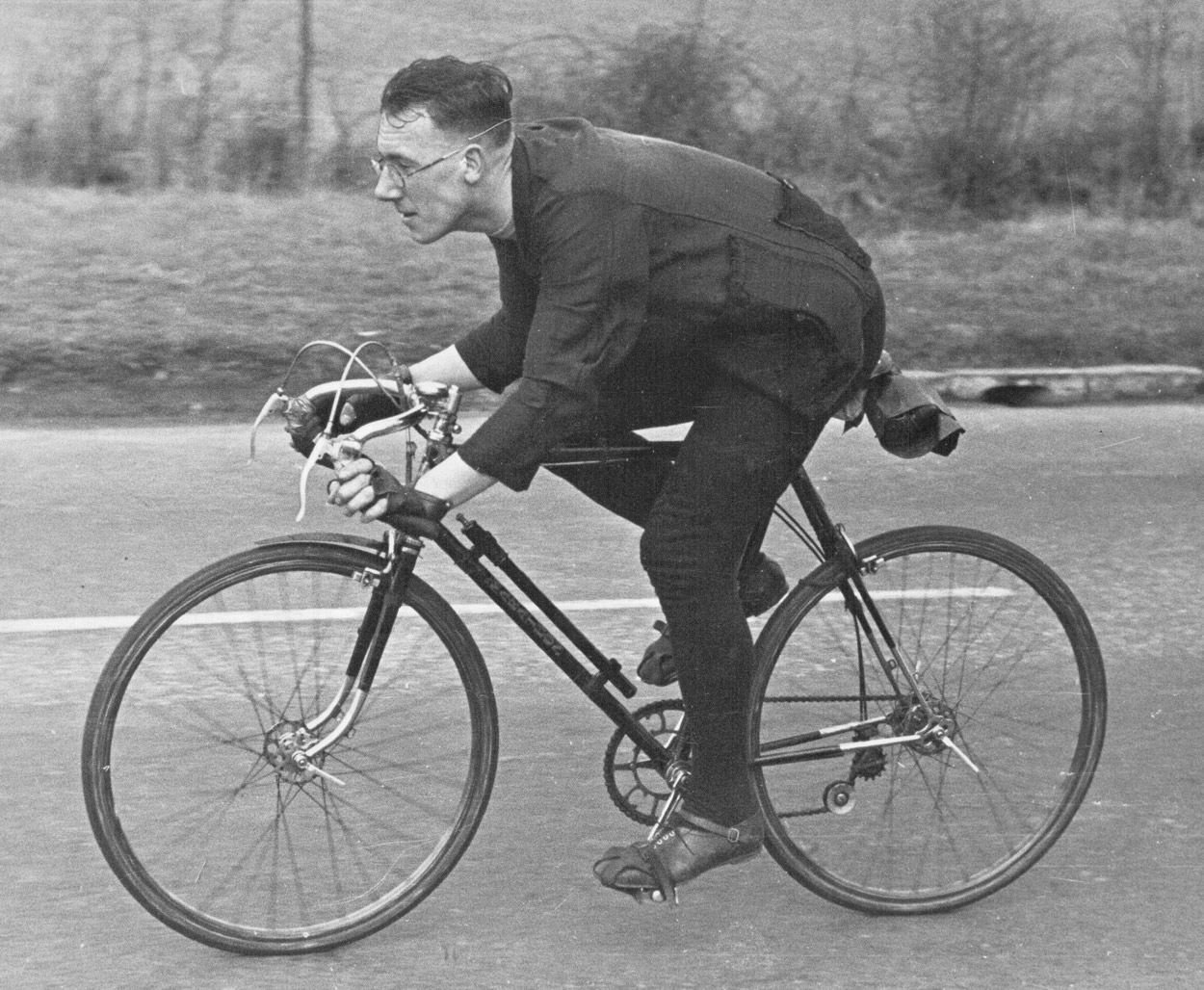The Horn Brothers - Cyril and Dennis
Posted: Wednesday 29th April 2020
The Horn brothers were born in Upwell being two boys in a family of six children Upwell is a village in Norfolk near the border with Cambridgeshire. Their father was a blacksmith and later kept a public house in Upwell. C W (Babs) Horn, born 7 October 1904, left school aged 12 and started working in the smithy for his father mainly making horseshoes for the British Army. This was of course during WWI. Dennis Sutton Horn was born 5th July 1909 and died 23 April 1974.
In the Fens where the Horn brothers lived, skating was very much part of winter life, especially the sport of speed skating. Part of the drainage system employed in this area resulted in thousands of acres of washland being flooded to a depth of around twelve inches (30 cm). In the severe winters, which were the norm at the time, these flooded areas soon froze over, creating skating rinks the size of large lakes. Also some racing took part on the frozen rivers which abound in the Fens. This drainage system was created by the Dutch who introduced the Fenmen to ice skating. Through the Fenland Skating Association races were organised every weekend for both amateurs and professionals, with prizes that were very generous considering the conditions of the day. One prize is quoted as ‘£2 plus a leg of mutton’. I would estimate a labourer’s wage to be less than £1 per week at this time. After WWI finished the Horns were both involved in agriculture, doing heavy work which would have kept them very fit.
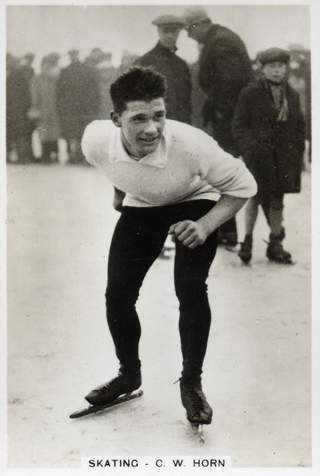
Cyril was featured in a cigarette card published by Senior Service cigarettes (J. A. Pattreiouex Ltd) in 1935. It was no. 93 of a set of 96 entitled Sporting Events and Stars (left). (Look at the lad in short trousers nonchalantly skating along with hands in pockets.)
It described Cyril as follows: “The fastest amateur skater in Great Britain and from 1927 to 1933 winner of the four British Championships held, his last triumph being in 1933 at Lingay Fen, Lincolnshire, with a time of 4.47¼ minutes over a 1½ mile course. The holding of these championships is entirely dependent on a very severe frost in order to freeze up this ideal skating course. In addition Horn holds the amateur records for 1½ mile 1929; 1 mile 1929 and 3 miles 1929, and a host of official skating trophies including International Amateur Race; Prince of Orange Bowl (1500 metre Circular Course); Duddleston Cup (1 mile race) – three successive wins including record time; Cameron Cup (¼ mile Race) – twice; Warner Cup (1 mile race); and also held 1929 ¼ mile Championship of Great Britain.”
Cyril was a national champion at both skating and cycling. In 1924 represented the UK at skating in the Olympics.
He was also featured in cigarette cards published by Park Drive entitled ‘Champions’ 2nd Series No 34 0f 48. It says: “C W Horn is the fastest man on ice in this country. Scored his fourth success in the Amateur Skating Championship of Great Britain on Lingay Fen, near Cambridge in 1933. Not only equalled the record of A G Tebbitt but finished 14 seconds in front of the rest of the ‘field’ of twenty-two starters. The race was originated by King Edward VII who presented the cup Mr Horn now holds with the stipulation that the race should always be held in the Fen country.”
A Times newspaper report, 29 April, 1929, of the National Skating Association Jubilee Celebrations, at Richmond Ice Rink, records: “The One Mile Speed Skating Race which followed (the exhibition skating) was contested by C.W. Horn, the Amateur Champion, D. Person, the Professional Champion, G.W. Martin and L. Stewart. Horn, skating beautifully, led from the start, and without ever being seriously extended, won in the excellent time of 3 min. 27 1-5 sec., which is the fastest time yet recorded for a mile on an enclosed rink. … After the exhibitions the various trophies won at this year’s ice speed-competitions were presented to the winners by the president of the association. C.W. Horn’s victories included the King’s Cup (Amateur Championship for Great Britain, 1.5 mile), Duddleston Cup (one mile), Prince of Orange Bowl (International Amateur Race), Quarter-Mile Championship of Great Britain, and the Warner Cup. …”
In the early 20s the brothers took up cycling as a sport – probably in the first instance to keep the leg muscles in tone during the summer months. Very soon they started to be as successful at cycle track racing as they were with their skating.
They were soon winning many cycling races on the track, in the rural areas almost every village and town would hold a combined sports event including athletics and grass track cycle racing. Anyone who has raced on grass will know that this is a very demanding sport both strength-sapping and requiring a very good technique to get speed and yet remain in control on the grass. In skating Cyril tended to be the better of the two brothers but in cycling they were much more evenly matched and I think that Dennis held the upper hand here.
The Horns soon became as adept on the track as they were on the ice and were regularly winning championships at both. It was widely expected that they could both represent their country as cyclists at the 1936 Olympics in Berlin. In the end neither were picked, it was surmised that their bluff Fen ways didn’t fit in too well with the sports establishment although they both had the potential to be medal winners.
In a taped talk Cyril says that he didn’t go (to the Olympics) as he wanted to stay here in the UK to win several cups outright. It was traditional to become the outright holder of a trophy if it was won three times in consecutive years and many of these trophies were solid silver, or even occasionally, gold. It does beg the question, was this eagerness to win for the prestige of owning the cup or would it be to use the cups as some form of insurance or pension? In track cycling events held soon after the Olympics the Horns comfortably beat the riders who had been sent to represent the UK. By now the brothers were racing all over the country, local tracks, Herne Hill, Portsmouth, Fallowfield in Manchester, even travelling as far as Glasgow to compete in the ‘Ibrox Park’ meeting in front of some 100,000 people.
The Horns were very astute at handling money and had their own transport, which was quite rare at this time. In his transcript Cyril explains how they shared the driving travelling around the country.
Good Friday Track Meeting, Herne Hill 1930 has both of the Horn Brothers as entrants. Going on to describe racing at Herne Hill in the early 30s it says; Two riders pre-eminent throughout this period were the Horn Brothers, Dennis and Cyril who became well known to the Herne Hill crowd. In 1933 Dennis raced against the German Champion Toni Merkens who won the sprint. However, Dennis came back to win the final of the 550 yards Scratch Race.
Cycling December 1936 contains a report on preparations for the Olympics and included in the team are the names of D S Horn or C W Horn. It goes on: “D S Horn, of course, holds the 1000 metres Trials Vest with the fastest time ever put up by an Englishman for this distance of 1min. 13¾ secs.”
Claud Butler, always a man with an eye on what was happening in the world of track cycling, took the Horns under his wing and supplied his state-of-the-art track machines for the brothers to compete on. Close examination of images of the Horns show Dennis on a Claud Butler track frame with small-flange hubs and cane sprint rims with grass-track tubulars taped onto the rim at three points. The stem is held in a headclip and is of medium length steel and the track bars have a long forwards ‘throw’. Chainset and pedals were BSA, always a trackman’s favourite, with inch-pitch ring, chain and sprockets. Saddle, a Brooks sprinter. The frame is close clearance and the fork crown is undrilled. The down tube transfers are of the block-letter variety which was common on track bikes. These machines could only have been ridden on the track as they were not road-legal. Mick Butler points out that the Claud Butler DSH International Path model was in fact named after Dennis Sutton Horn. See advert below for the DSH Path model from an advert at Wembley 6-day time in 1938.
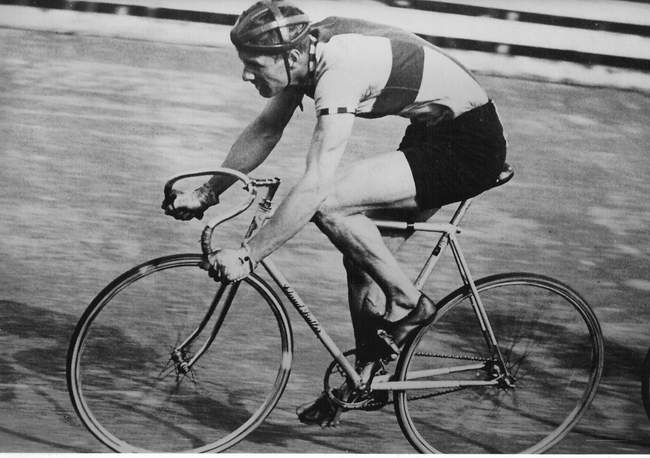
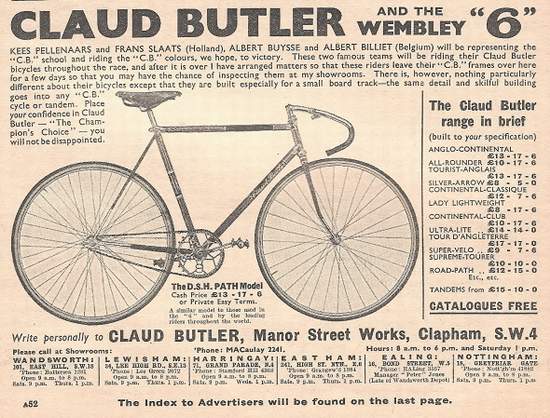
Such was the fame of the Horn Brothers that they could demand appearance money from race-promoters, insisting that they would lose a lot of money if they took time away from their businesses. With the combination of expenses, appearance plus prize money the Horns may well have earned as much as some professionals of the time.
In 1933 Bicycle magazine organised a road race at the Brooklands car racing circuit. They took this stance as the rival Cycling was so anti massed-start road racing. The event was over 62½ miles and included the 1 in 4 ‘test hill’ at the circuit. Dennis Horn as National Sprint and 25-mile Champion was invited to ride but had the misfortune to crash out on lap 4. Only fourteen of the ninety entrants finished the race which was won by J. J. Salt.
Younger brother Dennis Horn was also featured in a cigarette card published by Senior Service cigarettes (J. A. Pattreiouex Ltd) in 1935. It was no. 25 of a set of 96 entitled Sporting Events and Stars.
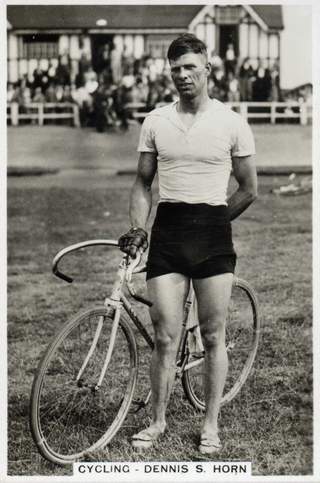
It described Dennis as:
“A champion specimen of the perfect cycling racing athletes who put up amazing speeds under their own power. Member of Norwich Amateur BC. National 25-miles cycling champion 1930-32-33-34; along with with Jack Sibbit (Manchester) was joint holder of the tandem championship 1932. Popular also in the North, and in July 15th 1935 won the 10-mile scratch race for the Murratti Cup and outright the 5Vi-Tonica gold cup for 1-mile scratch race in Manchester. Other great 1934 successes include: International Sprint; Corp. de Primes; Italian Pursuit Race; Madison Race; and many grass-track Championships including 5-miles. Still in his early twenties. Believes in plain feeding for stamina.”
Both brothers also abstained from drinking and smoking, believing that these would harm their fitness levels.
Although the brothers lived within a few miles of Wisbech, home of the Wisbech Wheelers, they raced under the colours of Norwich A B C (Amateur Bicycle Club) which was some 80 miles away.
In 1944/5 Cyril bought a small farm in Outwell and Denis was an arable farmer at Tilney All Saints. On this land his son David now runs a Golfing/Tennis centre. By now they had given up racing and were concentrating on their farming businesses and polishing their trophies in the evenings, one assumes.
So far this item seems to suggest that Cyril was a successful skater and Dennis a cyclist. This is the result of the way that information has come in. Cyril and Dennis were at the top of both sports. Research continues on this topic and we hope to add to the item in order to achieve a better balance.
To this day top speed ice-skaters in Europe, especially Holland, train on bikes in the summer, some becoming very competitive at both.
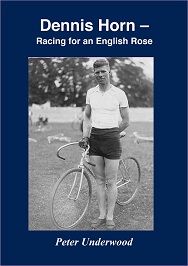
Cyril describes roller skating at the Hunstanton rink, as a callow youth I used to cycle to Hunstanton from King’s Lynn (16 miles each way) with friends and hire skates for a session. Eventually we learned to get round without making fools of ourselves but there were always the ‘Mister Cools’ skating around effortlessly and impressing the girls. Many years later I was loaned some ice skates and spent a day skating on fen ice. It was decades later when I skated on the Olympic ice-rink at Munich where hundreds enjoy family sessions on the ice – skating always seems to create a wonderful atmosphere.
Thanks to Geoff Adams, Cyril Bedford, Philip Doubleday and Gerry Moore for help with this item.
The author of this article, Peter Underwood, has since published a book on the exploits of Dennis Horn entitled: “Dennis Horn – Racing for an English Rose”, Mousehold Press, March 2013.
“At the age of 20, Dennis Horn won his first English Rose – the emblem of a National track champion. Throughout the 1930s he rapidly graduated from the rough and tumble of makeshift grass track racing at country fairs and gala sports days in provincial towns to assail the heights of British track cycling on the great urban cycling bastions of the time – the hard-surfaced stadiums of London’s Herne Hill and Manchester’s Fallowfield – and become the star of British track racing.”
Posted: Wednesday 29th April 2020
This article appears in the following categories.
Upcoming Events
Whether you are looking for a gentle social meet up, or a 100-mile ride browse the community’s upcoming events and plan your next weekend outing.
